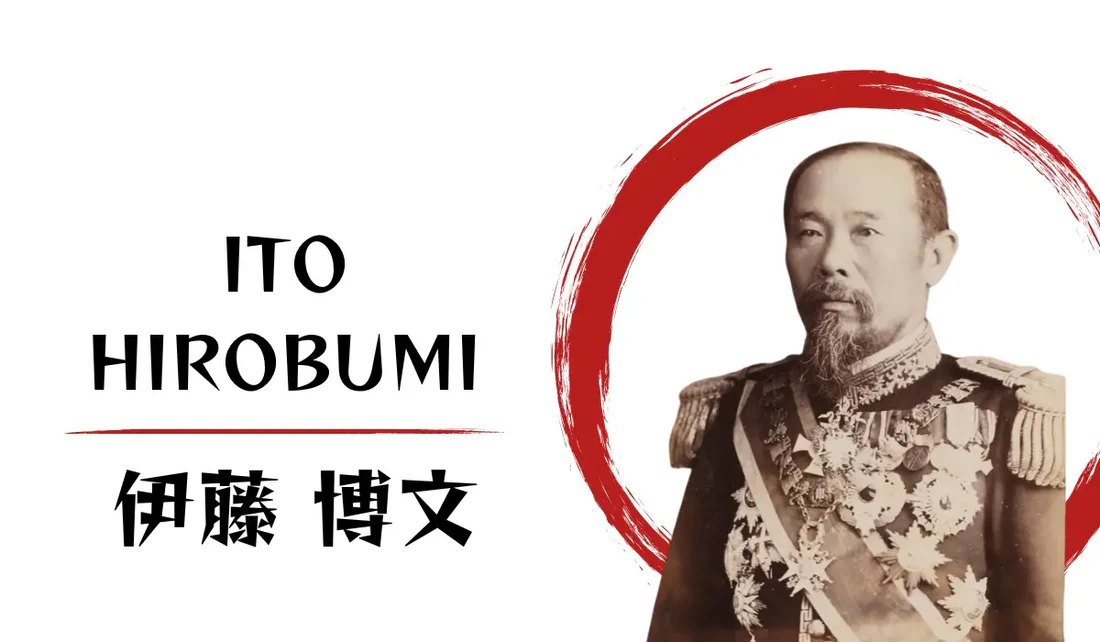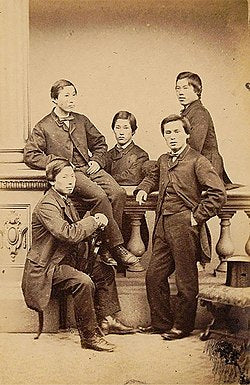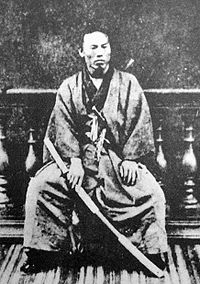
Itō Hirobumi
Share
Prince Itō Hirobumi (伊藤 博文, born October 16, 1841, died October 26, 1909) was a samurai from the Chōshū domain (present-day Yamaguchi Prefecture) who became a statesman during the Meiji era.
He was four times prime minister of Japan (the 1st, 5th, 7th, and 10th), genrō, and resident-general of Korea. He was assassinated by the Korean nationalist An Jung-geun. His son-in-law was the intellectual, politician and writer Suematsu Kenchō who married his second daughter, Ikuko.
Itō Hirobumi Family
Born "Hayashi Risuke" (林 利助) and then renamed in 1857 "Mizui Shunsuke" (水井 春輔), he came from a peasant family adopted by samurai from the Suō, who had since become impoverished and returned to the land.
His adoptive grandfather being adopted into the powerful Itō family of the Chōshū estate, he permanently takes this surname.
Itō Hirobumi Youth and studies
A very bright child, quickly noticed by the authorities of the Chōshū, he joined in 1857, on the recommendation of Kurihara Ryōzō and despite his low social rank, the school of Matsumoto, then directed by Yoshida Torajirō, a school from which he graduated in 1859, strongly influenced by the legitimist and xenophobic theses of his teacher.
After the announcement of the execution of his teacher by the shogunal authorities during the Ansei purge (1858 - 1859), he became involved in politics for good (1862) with his fellow student Katsura Kogorō on the side of the isolationist movement,
which had become the imperial doctrine of the Sonnō jōi (尊皇攘夷) since June 25, 1863, and became an activist in the movement for the abolition of the bakufu (倒幕運動, Tōbaku undō).
A staunch legitimist patriot, he first participated in the (aborted) plot against Yoshida's main (intellectual) rival in the Chōshū, Nagai Uta (長井 雅楽), as well as in various violent and spectacular actions, including the burning of the British legation (January 31) and the February 10 attack on Hanawa Tadatomi (塙 忠宝).
He was then sent on a mission by the Chōshū clan with four other intellectuals (the Chōshū five)5 to the United Kingdom to study European science and mores.
The Chōshū five studied at University College London (1863-1864) under Professor Williamson.
All of them then became aware of Japan's backwardness both politically, economically, and militarily, as well as scientifically and technologically;
the young Hirobumi, once a staunch opponent of Westerners and an advocate of Japan's isolation, learned a great deal from their contact and soon turned into a fervent supporter of the establishment of diplomatic relations and of the country's general opening to international trade.
Itō Hirobumi Political career

In 1864, Itō Hirobumi and Inoue Kaoru rushed back to Japan to convince the clan not to attack England : it was during negotiations with the representatives of the United Kingdom that he met the British diplomat Ernest Satow, himself a graduate of University College, with whom he remained friends.
His knowledge of Europe and his Anglophilia opened the doors of the new administration (Meiji restoration); he quickly obtained a position as an advisor (参与員, san'yoin) in charge of international affairs.
In 1870, he was sent with Yoshikawa Akimasa (芳川 顕正) and Fukuchi Gen'ichirō (福地 源一郎) to the United States to study the Western monetary system; upon his return to Japan in 1871, he was appointed director of the Department of Taxes and Duties, and later became vice-minister of Public Works.
In 1871-1873, he participated as vice-ambassador in the Iwakura (岩倉使節団, Iwakura shisetsudan) mission to the United States and Europe. In 1873, he was appointed as an advisor (参議員, sangi'in) and minister of public works.
In 1875, he presided over the first assembly of prefectural governors, as the elected official of Hyōgo Prefecture (兵庫県, Hyōgo-ken).
The death of Kido Takayoshi in 1877 followed by the assassination in 1878 of his superior, Minister of the Interior Ōkubo Toshimichi, allowed him to succeed the latter. From then on, nothing hindered his cursus honorum.
Until 1888, he was Prime Minister of Japan, a position he held four times, including during the Sino-Japanese War (1894-1895). He participated in the drafting of the 1889 Constitution and in the establishment of a bicameral parliament.
In 1889, he founded one of the first Japanese political parties, the Seiyūkai (政友会). He was one of the representatives of Japan during the signing of the Treaty of Shimonoseki, which marked the end of the Sino-Japanese War and allowed Japan to annex many of the territories previously under Chinese authority.

His attempts to avoid war with Russia aroused the discontent of the military.
Under their pressure, he was dismissed and became resident-general of Korea on December 21, 1905, following the treaty of Eulsa ratified in November, establishing the protectorate of Japan over Korea.
He was assassinated by the Korean resistance fighter An Jung-geun on October 26, 1909 at the Harbin train station in northeast China.
His portrait, with graying beard and mustache, was printed on old Japanese one-thousand-yen banknotes.
Itō had a close relationship with Louis-Émile Bertin, the founder of Japan's modern navy, throughout his mission to the Meiji emperor from 1886 to 1889.
He was elevated to the dignity of Grand Cross of the Legion of Honor on April 29, 1898.
Itō Hirobumi Distinctions
Decorations
- Grand Cross of the Legion of Honor
- Grand collar of the Supreme Order of the Chrysanthemum
- Supreme Order of the Most Holy Annunciation
- Grand Cross of the Order of Charles III of Spain
- Grand Cordon of the Order of the Paulownia Flowers
- Knight Grand Cross of the Order of the Bath
- Grand Cordon of the Order of the Rising Sun
- Knight of the Order of Saint Alexander Nevsky

